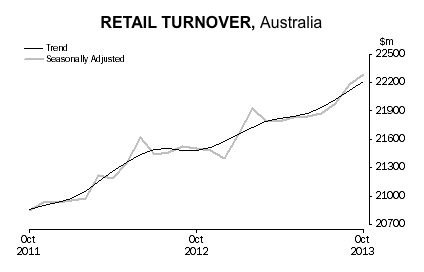Has the economy turned upwards after spending most of the past year meandering along at below trend, meaning interest rate cuts are at an end?
It certainly looks like it after the Reserve Bank sat on its hands again at yesterday’s final board meeting for the year and left its key cash rate unchanged at 2.5%.
Commentary from Governor Glenn Stevens suggests the bank is watching and waiting, which it is because there are no reasons to cut rates (or increase them for that matter).
But the flow of data suggests that the economy is starting to rebound with very solid figures for retail sales (the strongest annual rate for more than a year in October).
In fact there’s a suggestion the pace of economic activity may be growing a bit faster than we think as we head into the end of 2013 and the start of the New Year.
Building approvals remain solid as well, inflation is under control, and while manufacturing is weak, profits are recovering, along with those for the embattled mining industry (boosted by higher prices for iron ore).
And a strong performance on the trade account in the September quarter will boost GDP by 0.7%, according to the ABS yesterday, while the contribution from government spending will be a little stronger than forecast by economists.
Take retailing – it was the sixth positive monthly report in a row and the ABS said retail turnover was 3.6% higher in October compared to October 2012, higher than the 3.2% in the first quarter of the year and the highest rate of growth for more than a year.
In trend terms it was up an impressive 3.4%, which is faster than the growth rate in the wider economy and the inflation rate.
The ABS reported that retail turnover rose 0.5% in October, seasonally adjusted, following a rise of 0.9% in September (up from the originally reported 0.8%).
The trend rate of growth was 0.4% in October, the same as in September and August, indicating that retail sales are improving steadily. Annualised that’s closer to 5% which is very solid by comparison with the past couple of years.
The ABS said turnover rose in food retailing (0.5%), cafes, restaurants and takeaway food services (1.2%), other retailing (0.5%) and clothing, footwear and personal accessory retailing (0.6%).
These rises were partially offset by a fall in department stores (-0.3%). Household goods retailing was relatively unchanged. Over the longer term food retailing is the strongest contributor to growth (up 0.4% in trend terms).
Total retail spending was $22.285 billion in October, up from $22.180 billion in September and $21.563 billion in October 2012.
Retail and other data suggest economy is gathering strength

But a word of caution – as the ABS reminded us last month – the retail sales data now only covers 30% or so of total household final consumption spending (a key measure in the GDP data) because of the changing nature of consumer spending on more and more services. That has halved over the past 30 to 40 years.
The ABS is drawing up new measures to try and expand its coverage, but what it does mean is that the latest strong retail sales data might not be a wholly reliable indicator of a strong rise in household spending (although the data on home loan approvals, building approvals and car sales, for example, suggest consumers are opening the wallets a bit wider).
Turnover rose in NSW (0.7%), Victoria (0.3%), Queensland (0.4%), Western Australia (0.6%), Tasmania (1.3%) and the Australian Capital Territory (1.45%). Sales fell in South Australia (-0.3%) and the Northern Territory (-1.1%).
Those higher continuing iron ore prices and volumes helped push up the goods and services surplus in the September quarter to more than $2.8 billion (the balance of payments deficit rose to more than $12.7 billion).
But the 51% jump in the trade surplus will boost GDP by 0.7 points when the data is released later today. (That is just under the one percentage point boost recorded in the March quarter.)
The current account deficit was up from $12.091 billion in the June quarter.
Government spending on consumption and investment rose 7.4% in the third quarter to an inflation-adjusted $86.15 billion.
Spending for consumption rose 1.1% in the third quarter to $68.09 billion in real terms, stronger than many analysts had assumed.
Investment spending jumped 39.6% to $18.06 billion, but this was artificially lifted by the accounting treatment of the transfer of an asset between the public and private sectors (it’s not an accurate measure).
Offshore, China’s economy continues to expand solidly and we have had more data on the eurozone and US economies showing encouraging levels of expansion in manufacturing and services.
The test ahead for the dollar (gold) and shares comes on Friday night, our time, when the November jobs data for the US will be released.
A second monthly figure of 200,000 or more new jobs will firm up the chance the Fed will ease its spending in the New Year.
That could see the dollar reach the 90 USc level and gold fall under $US1200 an ounce back towards the mid year lows.













